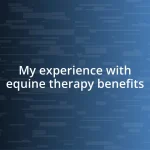Key takeaways:
- Patience in riding fosters trust and understanding between rider and horse, leading to stronger bonds and smoother interactions.
- Observing non-verbal cues and behavior of horses is essential, as patience allows riders to respond effectively to their emotional needs.
- Applying patience learned from riding to life situations can enhance communication, reduce frustration, and promote personal growth.

Lessons from Riding Animals
Riding animals has truly opened my eyes to the importance of patience. I remember the first time I mounted a stubborn pony that refused to move. It took a good ten minutes of gentle encouragement before he finally took a step. In that moment, I learned that forcing the issue leads nowhere; instead, patience creates a bond of trust between us.
One lesson I’ve particularly cherished is how non-verbal communication plays a massive role while riding. Have you ever noticed how animals respond to your emotions? I once had a particularly tense ride when I let my frustration show. My horse sensed my anxiety and became agitated. It was a vivid reminder that my energy directly impacts the animals, teaching me that patience isn’t just about waiting; it’s about fostering a calm and understanding presence.
I often reflect on how riding teaches me to embrace the journey, not just focus on the destination. On a long trail ride, I found myself overwhelmed by the thought of where we needed to be. But then, as the trees parted to reveal a bubbling creek, I realized that every moment of patience along the way is what creates those unexpected joys. Isn’t it fascinating how animals can teach us such profound life lessons if we simply take the time to listen?

Understanding Horse Behavior
Understanding horse behavior is an essential part of becoming a skilled rider. When I first started riding, I was often puzzled by my horse’s body language. A stiff neck or a pinned ear said more than words ever could. One time, during a lesson with a horse that kept circling instead of moving forward, I realized he was feeling cornered and uncertain. This experience highlighted the importance of observing subtle cues, reminding me that patience is critical in understanding the animal’s emotional state.
I’ve discovered that every horse has its own personality, just like people do. I remember riding a mare who was naturally curious but also easily spooked. Instead of rushing her, I learned to take my time and build her confidence. By gently approaching frightening objects, we developed a mutual respect. This not only made our rides smoother but strengthened our bond, reinforcing that patience pays off in relational dynamics.
It’s astonishing how horses communicate their needs without uttering a sound. One afternoon, I noticed my horse hesitating at a jump. Instead of insisting he follow through, I paused and watched. He was telling me he wasn’t ready. After giving him a moment, we approached the jump again, and this time, he soared over it effortlessly. This taught me that understanding horse behavior hinges on cultivating an atmosphere of patience, where both rider and horse can thrive together.
| Behavior | Meaning |
|---|---|
| Pinned ears | Aggravation or discomfort |
| Stiff neck | Stress or tension |

Building Trust with Your Horse
Building trust with your horse is a fundamental aspect of the riding experience that cannot be overlooked. Early in my riding journey, I vividly remember a day when my mare, Bella, wouldn’t come to me in the pasture. I felt disheartened, thinking she didn’t want to connect. But instead of chasing her, I stood still and calmly called her name. It took time, but eventually, she approached. That moment taught me that trust is built in these small acts of respect, not through force.
- Spend quality time together without riding.
- Approach your horse calmly, allowing them to come to you.
- Use consistent cues, so they know what to expect from you.
- Acknowledge their comfort zones; don’t push them past their limits.
- Be patient; trust develops gradually over time.
- Reward positive behavior with treats or affection to reinforce the bond.
Each of these steps can significantly deepen the connection between rider and horse. In those quiet moments of simply being present with Bella, I learned the value of patience in our relationship. Trust doesn’t come from action alone; it stems from a nurturing partnership where both horse and rider feel secure.

Practicing Patience in Training
As I immersed myself in training, I quickly learned that patience isn’t just a virtue; it’s a necessity. There were days when my horse, Charlie, simply didn’t want to cooperate, seemingly content to stand still rather than trot around. Initially, I felt frustration bubbling up; why wouldn’t he listen? But then I realized, rushing him wouldn’t change his mood. I had to take a step back, give him space, and allow him to come to terms with what we were doing. This moment of stillness taught me that sometimes, the best progress happens when we simply pause.
I remember a session where I spent what felt like an eternity perfecting the canter transition. Just as I thought we had it down, Charlie would either trot off or remain stubbornly at a standstill. It was discouraging, but I learned to break things down into smaller steps. By celebrating the tiniest victories, like achieving a couple of strides in the correct gait before he lost focus, I felt a shift in our training dynamic. I understood that every journey has its bumps, but with patience, we can navigate through them and celebrate small wins along the way.
On one particularly challenging day, I felt like we were going nowhere. My confidence waned, and I wondered, would we ever get better? In that moment, I decided to focus solely on my breathing. This not only calmed my nerves but also seemed to resonate with Charlie. Suddenly, he relaxed too, and I found we were able to connect in a way we hadn’t before. That experience solidified my belief that practicing patience is a two-way street; when I create a serene atmosphere, my horse responds positively. It’s incredible how training can flow when we allow ourselves— and our horses— the grace to just be.

Overcoming Challenges in Riding
One summer afternoon, I prepared for a lesson that seemed simple enough: perfecting our jumping technique. However, as I sat on my horse, Daisy, she refused to approach the jump. I was frustrated, thinking, “Why can’t she just trust me?” But deep down, I realized I hadn’t built enough confidence in her. Instead of forcing the issue, I decided to dismount and walk her through the course slowly. I learned that patience isn’t just waiting; it’s creating understanding in the partnership we’ve built.
During my first attempt at a canter after a long winter break, I underestimated how much Daisy might have forgotten. She stumbled a bit, and I could feel my heart race with worry. In that moment, I asked myself: how could I rush a horse that needed my support? Rather than pushing her through it, I took the time to reintroduce the cues she knew. I remember feeling relief wash over me when she finally got it; it was a quiet victory, reminding me that overcoming challenges requires not just dedication but understanding and trust.
Another instance that stands out is when I attempted to navigate a narrow trail with some steep drop-offs. Fear began creeping in as Daisy hesitated at the edge. I could have easily pushed her forward out of impatience, but instead, I chose to sit patiently in the saddle and speak to her softly. In that delicate moment, I realized overcoming challenges in riding is often about respecting the boundaries set not only by the horse but also by ourselves. It’s a shared experience, one where patience can turn intimidation into triumph.

Mindfulness Techniques for Riders
One mindfulness technique that truly resonated with me was the practice of visualization before riding. Picture this: I would close my eyes and imagine each segment of our ride, from the warm-up to the jumps. Believe me, it transformed my approach. Instead of just reacting to situations as they unfolded, I felt prepared, almost like I had already experienced the ride. It’s remarkable how a few moments of mental preparation can help center my focus and reduce anxiety.
Another technique that’s been effective is incorporating breathing exercises while on horseback. I vividly recall a nerve-wracking moment during a group lesson when I felt overwhelmed. Rather than letting my nerves spiral, I took a deep breath, inhaling through my nose, holding it for a moment, and then exhaling slowly. It wasn’t just calming for me; Daisy seemed to sense my tranquility. This shared calmness led to a more harmonious ride. Have you ever tried this? Just a few breaths can work wonders, not just for us but for our equine partners too.
Then there’s the technique of grounding, which involves being fully present in the moment. I remember a beautiful day, surrounded by nature’s sounds, and I started to pay attention to how the ground felt beneath my saddle and the rhythm of Daisy’s movements. It dawned on me that riding is not just about controlling my horse; it’s about experiencing the journey together. By soaking in those details, I learned to embrace both the thrill and the unpredictability of riding. Isn’t it fascinating how mindfulness can deepen our bond with our horses and enhance our overall experience?

Applying Riding Patience to Life
Riding has taught me that patience is not a luxury; it’s a necessity in life. I remember a morning when I found myself stuck in traffic, feeling that familiar frustration bubbling up. Instead of letting impatience take over, I reflected on how Daisy and I had to take things slow in our training. In that moment, I realized that, like her, some situations require a gentle push forward rather than forcing ourselves into the next step. By allowing time to unfold, I could clear my mind and even use that time for a little gratitude for the journey I’m on.
I once faced a challenging project at work that seemed to stall endlessly. My instinct was to rush everyone, pushing towards a near-impossible deadline. But then I thought about how patience had previously transformed my riding. I began emphasizing open communication with my team, allowing everyone to voice their concerns and ideas without rushing them. Surprisingly, what felt like a delay turned into a more enriched outcome, similar to when I give Daisy the time she needs to process something new. Isn’t it amazing how embracing patience in one area of our lives can reshape our perspectives elsewhere?
There’s an ongoing lesson in patience that’s echoed through my experiences with riding—it’s the understanding that real growth takes time. I recall an afternoon when a friend and I were training together and she grew frustrated with her horse’s insistence on being timid. I gently reminded her of the slow progress I had made with Daisy, emphasizing that every small step forward counts. Sometimes, I wonder how often we overlook the beauty in gradual improvement, both in riding and in life. Each moment spent in patience unveils new layers of understanding, fostering deeper connections with our world and ourselves.














